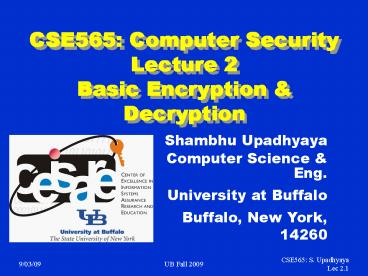CSE565: S' Upadhyaya PowerPoint PPT Presentation
1 / 13
Title: CSE565: S' Upadhyaya
1
CSE565 Computer SecurityLecture 2 Basic
Encryption Decryption
Shambhu Upadhyaya Computer Science Eng.
University at Buffalo Buffalo, New York, 14260
2
Overview
- Lecture 2 Overview
- Terminology (5 minutes)
- Encryption by Substitutions Transpositions (45
minutes)
3
Announcements
- Recitation for next week
- Properties of Arithmetic
- Inverses
- Divisors
- Prime Numbers
- Greatest Common Divisor
- Recitation for the following week
- Modular arithmetic
- Basic properties
- Operations
4
Terminology
- Encryption
- A process of encoding a message
- Decryption
- It is the reverse process
- Encryption Algorithms
- A key K is generally used
- Symmetric encryption
- Asymmetric encryption
Original Plaintext
Plaintext
Ciphertext
Encryption
Decryption
PD(C) D(E(P))
P(p1,p2, pn)
C(c1,c2, cm) CE(P)
5
Cryptography Cryptanalysis
- Cryptography
- Hidden writing -- encryption to conceal text
- Cryptanalysis
- Break an encryption
- Attempt to break a single message
- Attempt to recognize patterns in encrypted
messages - Attempt to find general weaknesses
- Breakable Encryption
- Given enough time and data, encryption can be
broken - Practicality is an issue
- Risky to proclaim an algorithm secure!
6
Substitutions Transpositions
- Substitutions
- Monoalphabetic Ciphers
- Polyalphabetic Ciphers
- These are called Stream Ciphers
- Transpositions
- Permutation
- These are Block Ciphers
7
Monoalphabetic Ciphers
- Caesar Cipher
- Formula
- Treaty Impossible --gt wuhdwb lpsrvvleoh
- Advantages Disadvantages
- Easy to perform
- Simple, so easy to predict the pattern
- Repeat characters give clue to break
- Permutation Cipher
- Use a key
- ABCDE
- K eyab.
- Since key is short, most plaintext letters are
only one or two positions off - Time complexity of these algorithms -- linear in
n where n is the no. of characters in plaintext
8
Polyalphabetic Substitution Ciphers
- Main problem with mono-alphabetic ciphers is the
non-flat frequency distribution - A flat distribution gives no information to
cryptanalyst - Flattening by combining distributions
- Two or more separate encryption alphabets for the
same character of the plaintext - E.g., one encryption for characters in odd
positions and another for at even positions - Reduces the repeat symbols in the ciphertext
- Makes it hard to break
- (Discussion of an example)
9
Vigenere Tableau
- Need to smooth out peaks and valleys of frequency
distribution - Can be done by extending no. of permutations
- Extreme case -- extend to 26 permutations
- A 26 X 26 table is used (discussion of example)
- Key word of length 3 is sufficient to smooth out
the distribution - Cryptanalysis of Polyalphabetic Substitution
- Reading exercise
- Focus on Kasiski method and Index of Coincidence
method (Look up Ref. Texts) - (http//www.trincoll.edu/depts/cpsc/cryptography/v
igenere.html)
10
Perfect Substitution Cipher
- Requires an infinite non-repeating sequence of
alphabets - This will confound the cryptanalyst
- One-Time pads
- Vernam Cipher
- Uses an arbitrarily long sequence of numbers
- Formula
- Random Numbers
- Middle digits of phone numbers in a residential
directory - Pseudo random numbers -- linear congruential
random number generator - Formula
11
Transpositions
- It is a method where letters of the message are
rearranged - Goal here is diffusion rather than confusion
- Information is spread widely across the
ciphertext - Columnar transposition is an easy one
- Characters are rearranged into columns
- (Study of an example)
- Encipherment/Decipherment Complexity
- Algorithm is constant in the amount of work per
character - Time is proportional to length of message
- Space required is directly proportional to
message length - Output characters cannot be produced until all
characters are read in - Delay depends on the length of the message
- Not appropriate for long messages
12
Cryptanalysis
- Digrams, trigrams other patterns used to break
encryption - Digram -- letter pairs such as -re- -th- -en-
-ed- etc. - Trigram -- groups such as ent, and, ing, thi etc.
- Cryptanalysis by trial error using a moving
window for comparison - This is a reading exercise! (http//en.wikipedia.o
rg/wiki/Transposition_cipher) - Double transposition algorithm makes breaking
more difficult - It uses transposition of a transposed text
- Discussion of example
13
Summary
- Stream Ciphers
- Mono and poly-alphabetic encryptions
- Since they convert one symbol of plaintext
immediately into a symbol of ciphertext - Features include a) speed of transformation, b)
low error propagation - Disadvantages are a) low diffusion, b)
susceptible to malicious insertions - Block Ciphers
- Columnar transposition algorithm and fractionated
Morse - Group of plaintext symbols are encrypted as one
block - Features include a) diffusion, b) immunity to
insertions - Disadvantages are a) slowness of encryption, b)
error propagation

